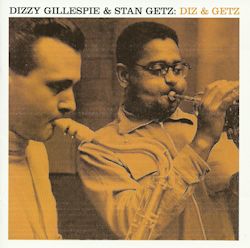1. It Don't Mean a Thing (If It Ain't Got That Swing)
2. I Let a Song Go Out of My Heart
3. Exactly Like You
4. It's the Talk of the Town
5. Impromptu
6. One Alone
7. Girl of My Dreams
8. Siboney, Pts. 1 & 2
9. Introduction by Norman Granz
10. Groovin’ High
11. The Nearness of You
12. ‘Round Midnight
13. We’ll Be Together Again
14. Shaw ‘Nuff
Dizzy Gillespie – Trumpet
Stan Getz - Tenor sax (tracks 1-5, 7-14)
Oscar Peterson – Piano (tracks 1-5, 7, 8)
Herb Ellis – Guitar (tracks 1-5, 7, 8)
Ray Brown – Bass (tracks 1-5, 7, 8)
Max Roach – Drums (tracks 1-5, 7, 8)
Hank Mobley – Tenor sax (track 6)
Wade Legge – Piano (track 6)
Lou Hackney – Bass (track 6)
Charlie Persip – Drums (track 6)
Sonny Stitt – Alto sax (tracks 10-14)
John Lewis – Piano (tracks 10-14)
Percy Heath - Bass (tracks 10-14)
Connie Kay – Drums (tracks 10-14)
Jazz is often portrayed as an individualistic art, and Louis Armstrong has been credited with throwing the spotlight on the individual soloist rather than
collective improvisers. Yet jazz is also a collaborative affair, in which the musicians listen to one another and react accordingly.
This album illustrates both these sides of jazz, with individual musicians showing their paces but at the same time co-operating with one another to
produce a collaborative unity. At times, Dizzy Gillespie seems to dominate these tracks – especially on fast numbers like tracks 1, 5 and 10, where his
attempts to break the sound barrier are both impressive and somehow excessive. The tempo of It Don’t Mean a Thing is ridiculously fast. This
hinders melodic creativity in the solos, which tend to be fragmentary rather than lengthy statements. Stan Getz is slightly more fluent than Dizzy, and
Oscar Peterson is more fluent than both of them. Max Roach is in his element, using clear, simple lines in his solos and plenty of cross-rhythms behind the
other players.
Yet despite the flaws in this opening track, it starts and ends with touches of magic. It opens with scattered notes from Gillespie and Getz, and ends with
an enchanting diminuendo. Both these effects depend upon the sensitivity of the frontline musicians, and it is rewarding to hear how, throughout the album,
they supply subtle counterpoint behind one another’s solos.
Impromptu
is another very fast tune, starting with a long, virtuosic piano solo by Oscar Peterson. Exciting though the up-tempo tunes may be, I prefer the medium
tracks like I Let a Song Go Out of My Heart and Girl of My Dreams, where the easy bounce enables the musicians to relax and invent. There
are also several ballads, like It’s the Talk of the Town, which is meditative, and tracks 11 to 13, which are like Norman Granz’s favourite device
of the ballad medley, enabling Gillespie, Getz and Stitt each to savour a favourite song.
The original LP was recorded in 1953. I’m not sure why One Alone is included here, as it was recorded a year later with Gillespie leading an
entirely different group. Hank Mobley gets a very short solo before the piece ends rather inconclusively. And Ernesto Lecuona’s Siboney is
delivered in two parts, without Getz on the first part and with Gillespie only entering the second part towards its close. But both players clearly relish
the piece’s Latin tinge, which so intrigued Dizzy and which Stan espoused with his adoption of the bossa nova.
Tracks 9 to 14 come from a 1956 Jazz at the Philharmonic concert, with altoist Sonny Stitt added to the front line and the previous rhythm section replaced
by the rhythm section from the Modern Jazz Quartet. Groovin’ High and Shaw ‘Nuff are both tearaway numbers, with the former’s
relationship to Whispering continually coming through the solos.
These recordings were just some of the collaborations between Dizzy Gillespie and Stan Getz. Their partnerships showed just what enchantment can be created
by two great jazzmen working in harmony.
Tony Augarde
www.augardebooks.co.uk
